East Sussex wartime writers and artists (2)
Posted: 6 August 2013 22:28
Part two of this series looks at artists and writers in the South Downs of East Sussex.
We'll cover an area from the cliffs at Newhaven to the rolling Downs at Firle and a couple of Downland villages and hamlets.
The Bloomsbury Group
This group of artists, writers and intellectuals had its origins in the early 20th century and was originally focused around Bloomsbury, London.
In 1916, Bloomsbury members Vanessa Bell and Duncan Grant moved to Charleston Farmhouse at the foot of the Downs near Firle. In 1919, Vanessa's sister, the feminist writer Virginia Woolf and her husband, Leonard, moved to Monk's House at Rodmell, about five miles away.
The collective's World War Two connection with East Sussex is twofold, one of which was tragic.
On 28th March 1941, with a history of depression, the destruction of her London home in the Blitz, and amid criticism of her recent literary work, Virginia Woolf drowned herself in the River Ouse. Her body was not recovered until 18th April.
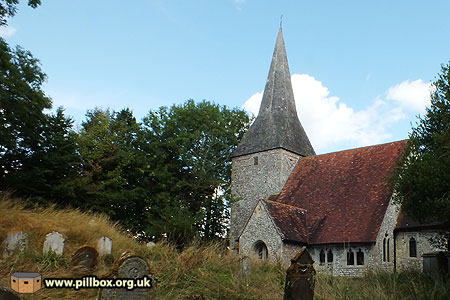
Our second Bloomsbury connection can be found in St Michael and All Angels Church at Berwick, photo at right.
Interestingly, the north- and south-facing aisle windows are of plain sheet glass; the Victorian leaded windows were damaged by bomb blast.
The church's website gives a date of 17th October 1944 and says plain glass was used in case of further damage. At this time, the culprit can only have been a V1 flying bomb, but the official data I have records no V1s landing in Sussex that day.
I suspect the V1 that crashed about 100m south of the church on 9th August 1944 damaged the windows. Being the third V1 down within half a mile of the church in four weeks, one can understand the reluctance to effect elaborate repair.
However, I digress!
In 1941 Bishop Bell of Chichester wanted to revive the tradition of murals in churches, and so Duncan Grant, Vanessa Bell and Quentin Bell were commissioned to paint the interior of a downland church.
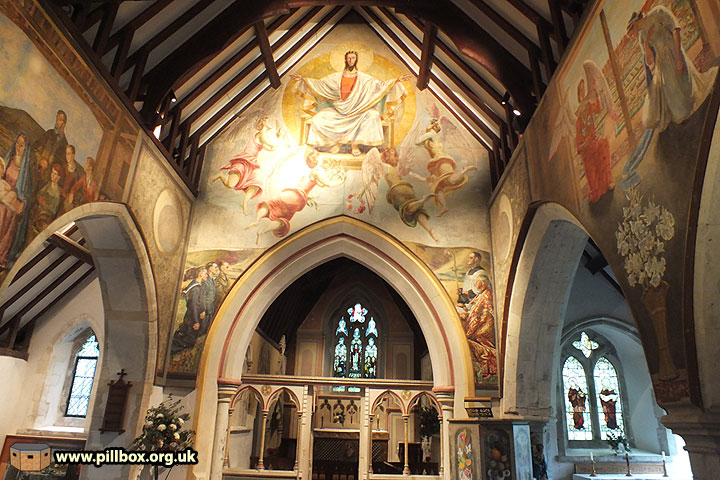
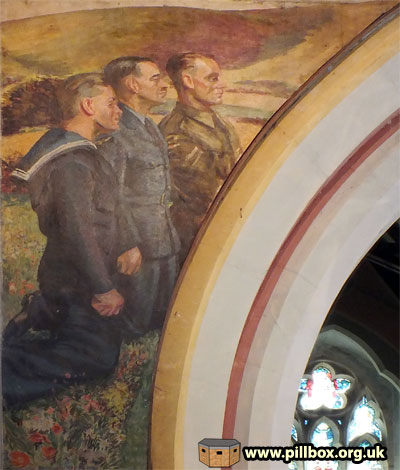
The murals are truly impressive - you really need to see them for real!
For me, the most interesting aspect of the Bloomsbury murals is the trio of service personnel painted to the left of the main arch.
According to http://www.berwickchurch.org.uk/christ in glory.html, these servicemen were actually from the village; the sailor was a Mr Weller, the airman a Mr Humphry and soldier Douglas Hemming.
Sergeant Hemming was sadly later killed in Normandy on 27th June 1944, making the poppies in the mural all the more poignant.
Hemming's details can be found on the Commonwealth War Graves Commission's website at: http://www.cwgc.org/find-war-dead/casualty/2326625/HEMMING, DOUGLAS GEORGE.
The murals appear to date between 1942 and 1944 and can be visited whenever the church is open.
Greater information about the murals can be found at: http://www.berwickchurch.org.uk/bloomsbury at berwick home.html
Charleston Farmhouse is open to the public March - October: http://www.charleston.org.uk/
Eric Ravilious
Having lived in Eastbourne from an early age, Ravilious had quite a portfolio of downland artwork before the war. He studied, and later taught at, the Eastbourne School of Art.
He was encouraged to take up wood engraving by Paul Nash; Ravilious' woodcut of two Victorian cricketers has been used on the cover of Wisden's Cricketers' Almanack since 1938.
In 1936, Wedgwood used his designs on ceramics, including a mug to commemorate the coronation of Edward VIII.
In 1940, Ravilious was appointed as an Official War Artist with the rank of Captain in the Royal Marines.
In October 1940, he painted a few scenes of the coast defences at Newhaven, one of which is shown below.
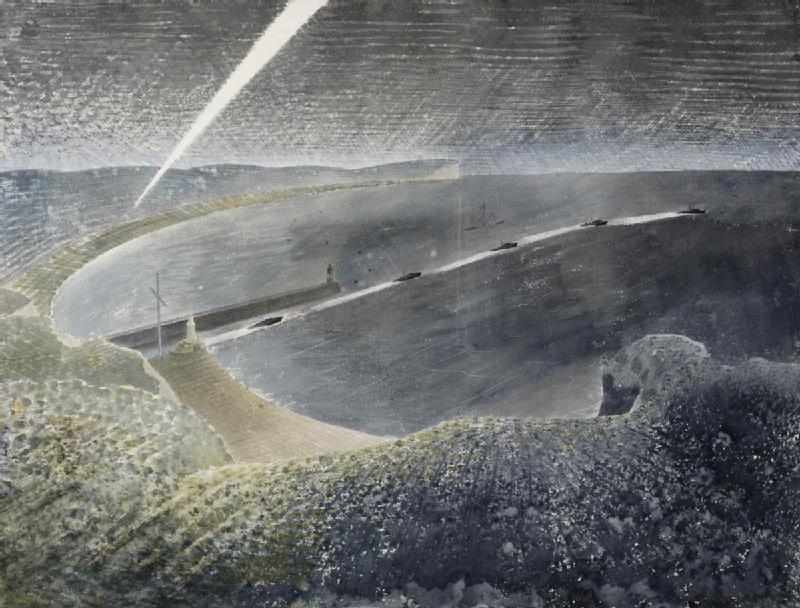 Coastal Defences (C) IWM (Art.IWM ART LD 5662)
Coastal Defences (C) IWM (Art.IWM ART LD 5662)The searchlight location does not fit with any records I have. There were a pair of coast defence lights at the Seaford Coast Defence Battery, but these were designed for surface work. The anti-aircraft beam may therefore be artistic licence.
The view across Newhaven Harbour entrance today is seen below; the general scene hasn't changed as much in the intervening years as one might think.
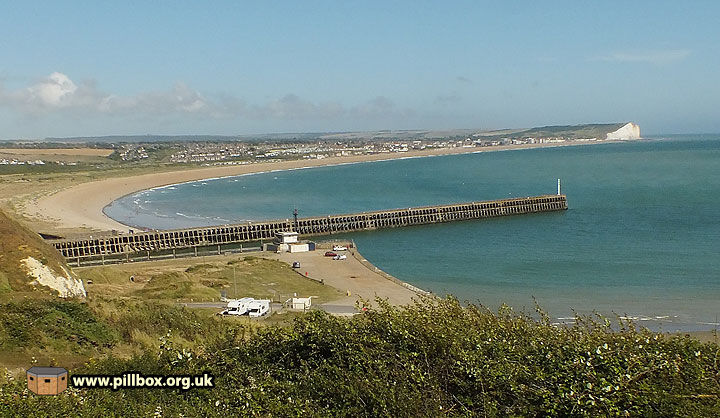
Another of Ravilious' Newhaven works looks down from the cliffs at the western arm of the harbour, and includes rows of dragon's teeth (cubes) and barbed wire entanglements on the beach.
Eric Ravilious was killed in September 1942, when an air sea rescue aircraft he was in failed to return from its mission.
Frank Newbould
Between the wars, Frank Newbould had designed travel posters for various railway companies. In 1942 his talents were turned towards morale as he joined the War Office and was responsible for four of the designs in the Your Britain, Fight for it Now campaign.
Two of Newbould's works were based on Sussex scenery; Newbould helpfully subtitled the work below 'Alfriston Fair'.
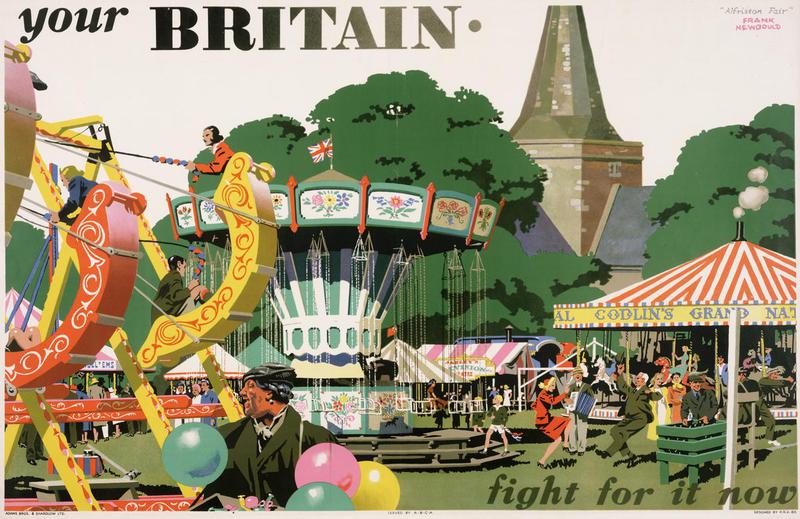 Your Britain Fight for it Now Alfriston Fair (C) IWM (Art.IWM PST 3642)
Your Britain Fight for it Now Alfriston Fair (C) IWM (Art.IWM PST 3642)The same viewpoint today in the photo below reveals that the trees have been cut back and so more of the church is visible:
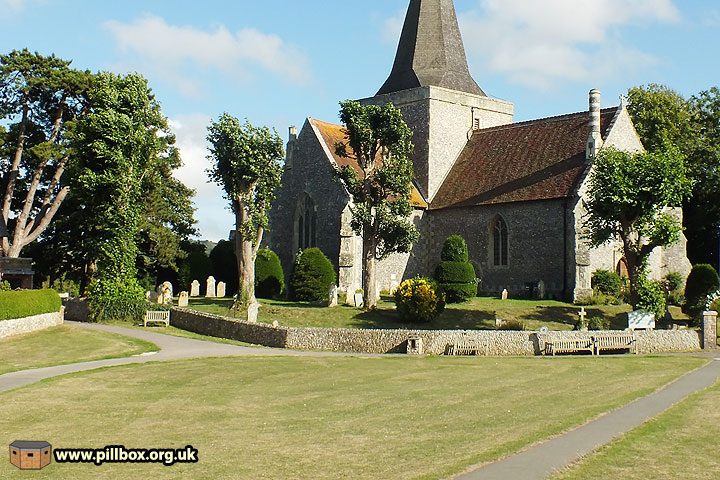
However, it is Newbould's other Sussex depiction that has held my fascination for many years. Titled 'The South Downs' (below) my description of this requires a separate post in order to do it justice!
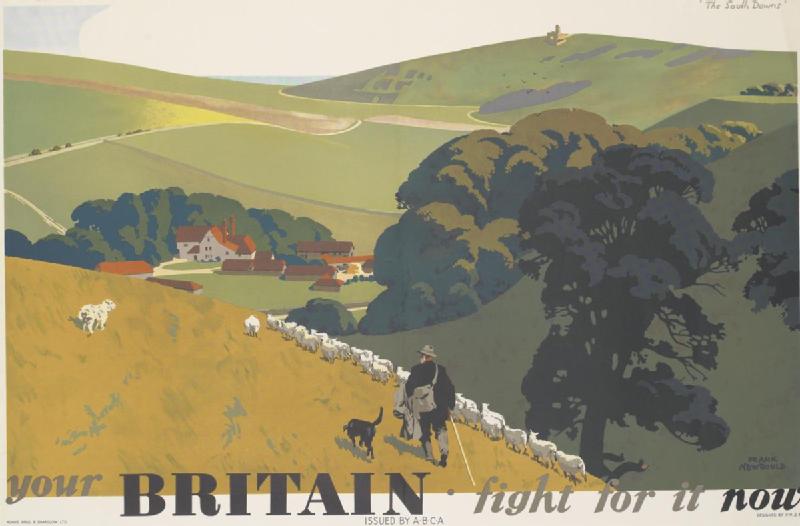 Your Britain - Fight for it Now South Downs (C) IWM (Art.IWM PST 14887)
Your Britain - Fight for it Now South Downs (C) IWM (Art.IWM PST 14887)- Pete

Email:
Blog Latest

Bishopstone reveals its pillbox secrets
18 October 2021

Pillbox or Observation Post?
10 June 2020

Uncovering the hidden secrets of a pillbox
8 June 2019

Review of 2018
31 December 2018

Wartime Christmas in East Sussex (2)
24 December 2018
Jargon-buster
Cubes
Anti-tanks blocks, popularly known as dragon's teeth. Not to be confused with smaller blocks known as pimples, cubes can be upwards of 1m square. Many examples in Sussex have apexes or chamfered edges, leading to them being incorrectly recorded as coffins.
This site is copyright © Peter Hibbs 2006 - 2024. All rights reserved.
Hibbs, Peter East Sussex wartime writers and artists (2) (2024) Available at: http://pillbox.org.uk/blog/216729/ Accessed: 27 July 2024
The information on this website is intended solely to describe the ongoing research activity of The Defence of East Sussex Project; it is not comprehensive or properly presented. It is therefore NOT suitable as a basis for producing derivative works or surveys!